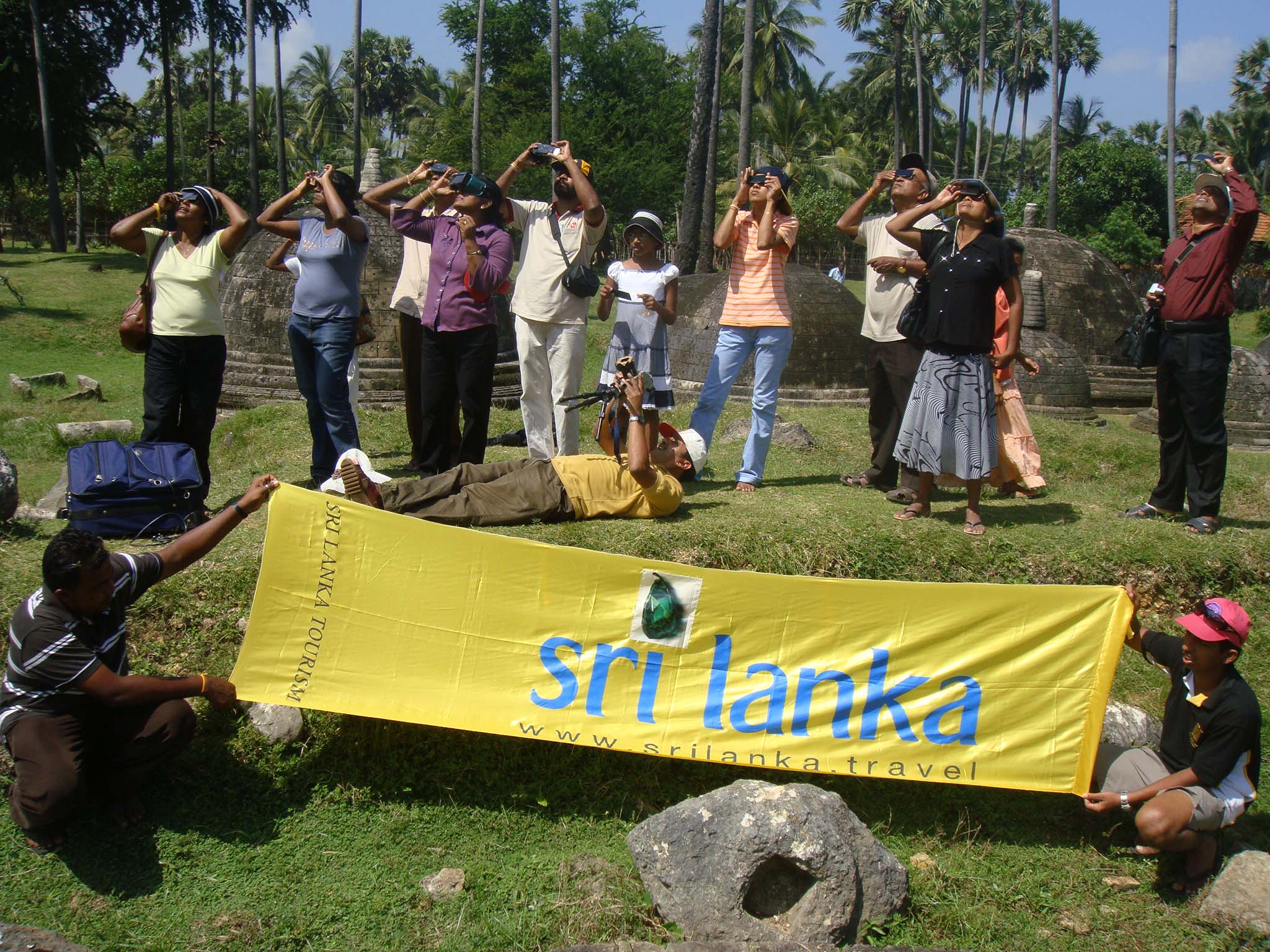
Six years after I first
flew into Jaffna
in 2003 May, the civil war had ended and the A9 highway was now
finally open with no travel restrictions. The
Annular eclipse of the Sun on 2010 January 15th
was a good reason to return to Jaffna. I decided to join the a trip
organized by Haka Lanka Tours
for the Archaeological Society. Members with family and friends from
age 3 to 80, were excited to see the Eclipse and Jaffna, most for the
first time.
We hired a Bus like that is being used for super Luxury transport
every night from Wellawaththa to Jaffna. It even had a toilet like in
long distance coaches abroad. However the owners had locked toilet up for
"practical reasons" :-)
We met at the Colombo Museum on the 12th evening and left at about 10
PM in a large Tourist Coach. Although travel via Puttalam is 10 km
shorter the 74 km from Puttalam to Anuradhapura was very slow and
bumpy due to road construction. After an early breakfast near
Anuradhapura we traveled via Vavunya, and crossed over at Omantai to
former LTTE held territory. We had obtained letters from the Ministry
of Defense, but it was hardly needed. Throughout the journey, any
checks were just a quick formality, no different to those encountered
in Colombo.
The former war zone was hardly populated except by the Army. Most
Buildings were in ruins with no roof. Reconstruction has still to
start. Land-mine signs still cordoned off land even close to the
A9. We saw some demining activity using an automated crawler type
deminer gifted by the UNHCR. Stopped briefly at Killinotchi, some of
us sent off postcards from the Post Office which was one of the few
government institutions to function through the years the territory
was under the LTTE. The large Water Tank which was
toppled
by the retreating LTTE portrayed the devastation.
The few new War Memorials were the only other tourist stops on the
way into Jaffna. The memorial at Killinotchi was very symbolic. A large
bullet, cracked open a solid bunker and a blue lotus is shown blooming
above. The Memorial at Elephant pass had 4 hands lifting up a united
Lanka, and the blue Lotus which is the national flower of Lanka.
With various stops we got into Jaffna in the late afternoon. Most of
the group were staying at the Guest House of the Naga Vihara. Since that
was over crowded and in poor condition, being still mostly occupied by
the Forces stationed in Jaffna, few of us stayed in the Cozy Rest
which was round the corner. It was the hotel with the most number of
Rooms and it's restaurant has become a hub for foreigners and expats
who can afford the inflated prices, due to the lack of significant
competition.
After settling into our accommodation we did not have time to see the
places we hopped to visit that day. The Nallur Kovil being prepared for
the Thai pongal festival the next day had closed early. We visited the
locally famous Rio Ice Cream parlour, and marveled that we were able to walk
freely around late at night.
The next day we left early to get to the ferry to visit Nagadeepa. The
Ferry which was just leaving was too full to accommodate our group of 42,
and we needed to wait for the next, for the short 3 km ride. They were
finding it difficult to cope with the sudden influx of tourists. The
ferries are old and not very pleasant inside.
The whole of the Jaffna peninsula was known as Nagadeepa, the island
of the Naga people. The famous Nagadeepa vihara on the Nainativu
island is a site which is believed to have been visited by the
Buddha. Hardly any of the ancient site remains in the temple of
worship. Off the beaten track however, within walking distance is a
small site called Buddha Walauwa with an ancient statue of Buddha.
The largest island Neduntivu is better known by it's Dutch name
Delft. We hired a ferry for the group, and the journey of over one
hour was nice. I was able to sit with my friend right in front on top
and get away as far as possible from the loud engine. When we arrived
we were told to get back to boat before 3 PM because the sea was rough
after 4 PM.
The Delft island is home to a few thousand people. Transport is
limited to a single bus and a few Trishaws. The only other vehicle
which could take us to the sites of interest was a tractor with
trailer. We piled into the trailer for a rollercoaster like ride as
the driver tried to show us the sites in the limited amount of
time. Wild ponies are symbolic of Delft and we saw few of them.
We first visited an ancient site with the base of two Stupa which has
not yet been properly documented or excavated. We next visited the
ruins of the small Portuguese Fort behind the hospital. It had thick
walls made of broken coral, like most of the fences on the island. The
next site was the Baobab tree, which is the longest lived species of
trees and native to Ethiopia. Since we got late, the return journey
starting about 5 PM was very rough and a few got sea sick.
Had dinner at Cozy Rest. The ACCIMT team had also come there for
dinner. They were setting up a camp at the Jaffna University to
observe the Eclipse.
The next day we left early again, to see some sites before the Eclipse
started. The Mavaddapuram kovil had an old Vail cart with intricate
carving. The Naguleswaram Shiva Kovil, and the nearby baths of
Keerimalai hot springs was next. We then traveled to Jambukola where
Sanghamitta Theri landed with the Bo-Sampling. The Ancient site has
got destroyed and has been tastefully reconstructed recently. Being
within the HSZ it had been out of bounds till a few days before that
day.
We decided to observe the Eclipse from Kathurugoda (Kantharodai) which
is a unique 3rd century BCE Buddhist site with over thirty small stupa
a few meters in height and diameter. It would have taken us too long
to travel to the
observing camps at Hindu College set up by
skylk
group, or the Jaffna University setup by ACCIMT group, which we also
knew would be crowded. I had purchased a large number of 2x4 inch
Shade 13 Welding glasses so that everyone can view it safely. On are
way we passed a school where we saw children looking at Sun without
protection. The Safety message had obviously not got through. We stopped and
gave them a welders glass.

Modern point and click digital cameras don't provide a manual mode where you can set Focus, Aperture, and Exposure time. The manufactures assume they can set the required aperture and exposure time better than you and does not allow you to do so. A Manual Mode is only available in the expensive professional cameras. I had found out that my new 12 MB Olympus FE 5010 was not very useful for the task.
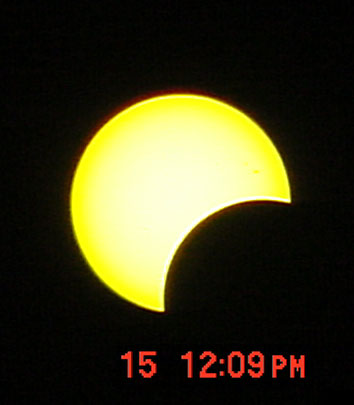
| 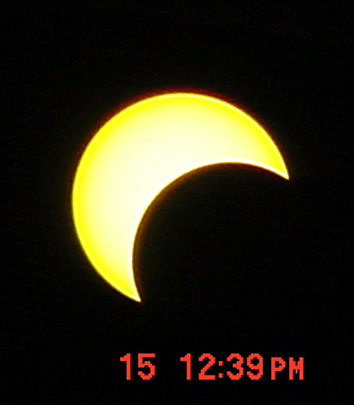
| 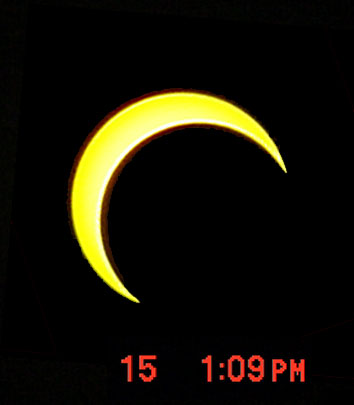
|
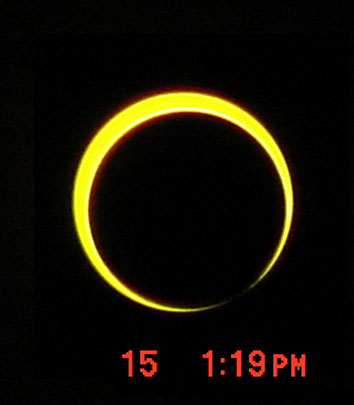
| 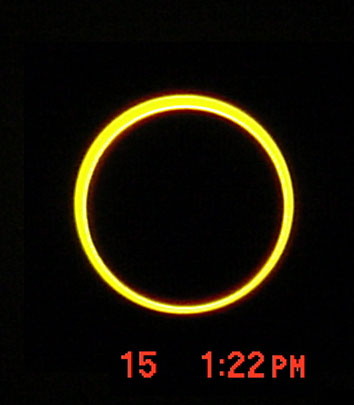
| 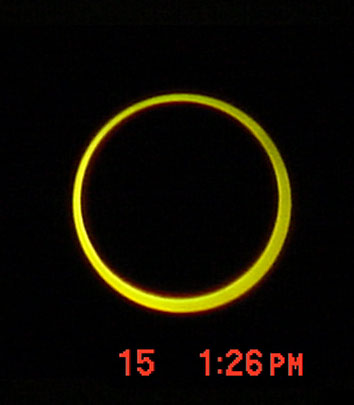
|
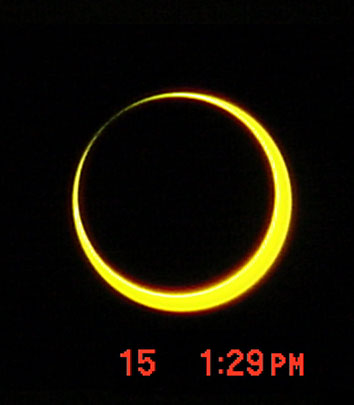
| 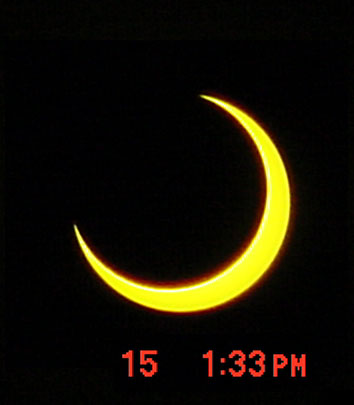
| 
|
I had therefore brought my large, nine year old Sony Mavica FD97 digital camera for photography. It is only 2.1 MB, but has a 10X optical Zoom and steady shot. I locked the focus to infinity and switched off Auto-focus, and set shutter speed to 2 milliseconds (1/500). I taped a 2-inch diameter shade 13 welders glass disk I had got cut out in front of the lens. My 12x50 Binoculars also had 2 such disks pasted in front of objectives.
The sky was perfectly clear with no clouds. We had selected and ideal spot to observe the Eclipse. By sleeping on the ground and hand holding the Camera, I was able to get a nice series of 150 photographs, mostly of the Annular eclipse from 1:20 to 1:30 PM.

During the partial phase I looked for a tree under which I could see multiple crescent Sun images by the random pinholes made by the leaves as they moved in the wind. The 10 minute Annular phase was long enough to go and see the rings under the same tree.
After the eclipse we returned to Jaffna and visited a few more sites, the Nallur Kovil, the Sangili Topu, the Mandri Manai and the Jaffna Fort.
Had dinner with the skylk group which had been sponsored by Tamil daily Virakesari and had webcast the event from at observation camp setup at the Hindu College in Jaffna.
The Group I had come Jaffna left for Colombo on the 16th Morning. I made contact with Dr Pushparatnam, head of the History Department of the University of Jaffna, and decided to stay over to meet him on the 16th and see his Coin collection.
Had opportunity to drink some Palmyrah Toddy which didn't have a taste which was special. After being redirected by two Liquor stores I was able to buy few bottles of Palmyrah Arrak which has limited production and not available in Colombo. Unfortunately the quality was clearly not as smooth as I remember from 2003.
That evening I joined up with the Thawalama Group, to return back to Colombo on the 17th. They were staying at a building which was being occupied by the Army and had army style beds with Mosquito net attached to a frame with 4 post. We left on the 17th at about 8 AM and after few stops on the way we were back in Mount Lavina by 8 PM after few stops at Killinotchi, Irattaperiyakulam for Lunch and at Anuradhapura. Had dinner at New Light House Hotel in Wattala.
It was clearly a great 5 day trip to Jaffna. There will be no more Solar eclipses, even partial visible from Lanka till the next annular eclipse of the Sun on 2019 Dec 26th, visible only from Jaffna. Jaffna would then probably be a lot different from what it is Today.